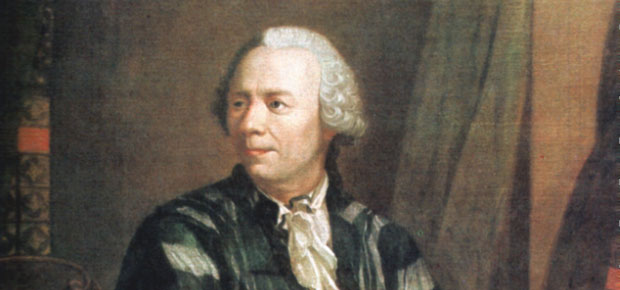| Line 3: | Line 3: | ||
Euler's Number, written as <math>e</math>, has become one of the most important constants used in numerous different fields of mathematics. Its value is approximately 2.718; however, it is an irrational number, so its exact decimal representation is infinite. | Euler's Number, written as <math>e</math>, has become one of the most important constants used in numerous different fields of mathematics. Its value is approximately 2.718; however, it is an irrational number, so its exact decimal representation is infinite. | ||
| + | Jacob Bernoulli originally discovered an approximation for the constant in 1683 while doing work related to compounding interest. Although, it was not until Swiss mathematician Leonhard Euler studied the number in 1731 that the constant was written with the symbol <math>e</math> that is so widely used today. | ||
| − | + | Euler was born the son of an Evangelical-Reformed minister in Basel, Switzerland, on April 15, 1707, and 17 years later, Euler graduated from the University of Basel. After this, he was invied to join the Academy of Sciences in St. Petersburg, Russia where he became a professor of physics in 1730 and later a professor of matheamtics in 1733. In 1941, Euler, after being called to Berlin, became director of mathematics in the Academy of Sciences (Berlin) until 1766 when Euler decided that he would return to St. Petersburg to assume the position of director of the Academy of Sciences (St. Petersburg). Shortly after Euler returned, he became blind. Nonetheless, he continued to create books and papers. He died in St. Petersburg on September 7, 1783. (5) | |
[[File:Leonhard-euler.jpg|framed|right|Leonhard Euler (1707 - 1883)]] | [[File:Leonhard-euler.jpg|framed|right|Leonhard Euler (1707 - 1883)]] | ||
| − | + | Since then, the number has played important roles in a number of fields including but not limited to: finance, calculus, engineering, and physics. | |
[[Category:MA279Fall2018Walther]] | [[Category:MA279Fall2018Walther]] | ||
Revision as of 23:17, 2 December 2018
Introduction
Euler's Number, written as $ e $, has become one of the most important constants used in numerous different fields of mathematics. Its value is approximately 2.718; however, it is an irrational number, so its exact decimal representation is infinite.
Jacob Bernoulli originally discovered an approximation for the constant in 1683 while doing work related to compounding interest. Although, it was not until Swiss mathematician Leonhard Euler studied the number in 1731 that the constant was written with the symbol $ e $ that is so widely used today.
Euler was born the son of an Evangelical-Reformed minister in Basel, Switzerland, on April 15, 1707, and 17 years later, Euler graduated from the University of Basel. After this, he was invied to join the Academy of Sciences in St. Petersburg, Russia where he became a professor of physics in 1730 and later a professor of matheamtics in 1733. In 1941, Euler, after being called to Berlin, became director of mathematics in the Academy of Sciences (Berlin) until 1766 when Euler decided that he would return to St. Petersburg to assume the position of director of the Academy of Sciences (St. Petersburg). Shortly after Euler returned, he became blind. Nonetheless, he continued to create books and papers. He died in St. Petersburg on September 7, 1783. (5)
Since then, the number has played important roles in a number of fields including but not limited to: finance, calculus, engineering, and physics.


